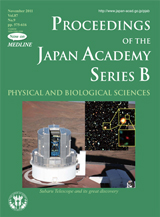About the Cover
Vol. 87 No. 9 (2011)
One of the major issues in modern astronomy is how the primordial density fluctuations left on the cosmic microwave background radiation originated the galaxies and larger cosmic structures we see today. Since the speed of light is finite, we can directly conduct a survey for galaxies at different ages of the Universe, to trace the formation history of the cosmic structures. However, we have two difficulties to overcome. First, the more distant an objects is, the fainter it looks; the apparent brightness of a source diminishes with the inverse square of its distance. Second, due to the expansion of the Universe, the wavelength of light from a distant object shifts to a redder one. These two factors make it difficult to find and investigate very distant objects. To see an early phase of galaxy formation and evolution, we need a telescope with a large aperture to catch much light from distant objects, and an instrument sensitive to photons in red wavelengths.
The cover picture shows the 8.2m-aperture Subaru Telescope on Mauna Kea, one of the largest optical and infrared telescopes to date. Subaru has a fabulous optical and near-infrared camera, Suprime-Cam, mounted on its prime focus. The instrument has a fairly wide field of view, which is as large as the size of the full moon, and also a mosaic of CCD detectors sensitive to a very red wavelength (~1µm). As the article on page 575-586 of this issue reviews, Subaru blazed new trails to the dark age of the Universe. The red object in the inset pictures is the most distant galaxy, IOK-1, at the time Iye et al.(2006) discovered it using Subaru/Suprime-Cam, and remained at the top of the distant galaxy list for about four years. Although the number of such distant galaxies found so far is small, the next-generation instrument, Hyper Suprime-Cam, having seven times wider field of view than Suprime-Cam, will enable us to discover a significant number of very distant objects in tremendously huge cosmological volumes, and play an important role in understanding the cosmic structure formation history.
Graduate Student
Department of Astronomy, Graduate School of Science, The University of Tokyo




